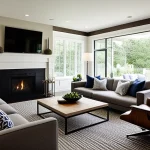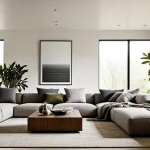The Role of Home Décor in Creating a Sanctuary
Creating a home décor sanctuary begins with intentional choices that cultivate a peaceful living space tailored to your needs. Key elements include soft, inviting textures and a color palette that soothes the senses, such as muted blues, greens, or warm neutrals. These choices are foundational to crafting a personalized home environment that feels both comfortable and rejuvenating.
The psychological impact of decorating thoughtfully cannot be overstated. A sanctuary-inspired space encourages relaxation by subtly signaling to your brain that this is a retreat from daily stresses. When your surroundings are organized, harmonious, and reflect your personal taste, it fosters a sense of control and calmness.
Also read : How Can You Transform Your Living Room into a Relaxing Sanctuary?
Comfort and relaxation start with the basics: ergonomic furniture arranged to promote ease of movement and social connection, combined with ambient lighting that mimics natural daylight or creates warmth. These elements work together to turn your living area into more than just a place to inhabit—it becomes a true sanctuary for mind and body. Prioritizing these aspects of your home décor sanctuary supports emotional wellbeing, making it easier to unwind and recharge after each day.
The Psychological and Emotional Benefits of Thoughtful Home Décor
Thoughtful home décor sanctuary design plays a crucial role in supporting mental well-being by creating an emotional retreat within your living space. Research shows that surroundings influence mood and stress levels profoundly. A peaceful living space designed with intention signals safety and calm, helping reduce anxiety and promote relaxation. This emotional retreat grants a psychological buffer from daily pressures, enhancing resilience.
Topic to read : Why Choose Sustainable Decor Trends for Your UK Home?
How does décor reduce stress? It’s through the combination of soothing colors, organized layouts, and tactile elements that comfort the senses. These intentional choices engage the brain on multiple levels, encouraging a restorative effect. For example, natural hues stimulate calmness, while clutter-free environments lower cognitive load.
Creating a personalized home environment that caters to your emotional needs fosters a sense of control and security. This connection between aesthetics and emotional health is essential in turning any dwelling into a sanctuary. Ultimately, investing in thoughtful décor is not just about visual appeal—it’s a practical tool for enhancing overall mental well-being and establishing a calm refuge that supports everyday balance.
Key Décor Elements That Transform a Living Space
Transforming your living area into a home décor sanctuary hinges on deliberate choices in color, lighting, furniture, and textures. Color psychology plays a pivotal role; soft blues and greens are known to induce calm and lower stress levels, creating a peaceful living space. These hues interact with our brain chemistry, promoting relaxation and emotional balance.
Lighting sets the mood further. Combining ambient lighting that mimics natural daylight with warmer tones helps regulate circadian rhythms and nurtures a soothing atmosphere vital for a personalized home environment. Adjustable lighting options allow you to shift from bright energizing light to dim, cozy settings conducive to relaxation.
Furniture arrangement impacts both flow and comfort. Positioning seating to encourage social connection or quiet reflection tailors the space for your needs. Avoid cluttered layouts that disrupt movement; open, balanced arrangements enhance physical ease and mental clarity.
Lastly, texture layering introduces tactile comfort and visual warmth. Combining soft fabrics, natural materials, and varied surfaces appeals to multiple senses, deepening the sanctuary’s restorative effect. Thoughtful use of textiles, such as plush cushions or woven throws, adds depth without overwhelming simplicity, reinforcing a calm, inviting home décor sanctuary.





